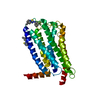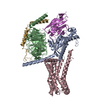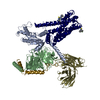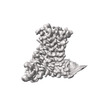+ Open data
Open data
- Basic information
Basic information
| Entry |  | ||||||||||||||||||
|---|---|---|---|---|---|---|---|---|---|---|---|---|---|---|---|---|---|---|---|
| Title | Cryo-EM structure of the AA14-bound GPR101 complex | ||||||||||||||||||
 Map data Map data | |||||||||||||||||||
 Sample Sample |
| ||||||||||||||||||
 Keywords Keywords | GPCR / orphan receptor / GPR101 / constitutive activity / cryo-EM / structural protein / MEMBRANE PROTEIN | ||||||||||||||||||
| Function / homology |  Function and homology information Function and homology informationadenylate cyclase-activating adrenergic receptor signaling pathway / G protein-coupled receptor activity / receptor complex / positive regulation of MAPK cascade / plasma membrane Similarity search - Function | ||||||||||||||||||
| Biological species |  Homo sapiens (human) Homo sapiens (human) | ||||||||||||||||||
| Method | single particle reconstruction / cryo EM / Resolution: 3.3 Å | ||||||||||||||||||
 Authors Authors | Sun JP / Yu X / Gao N / Yang F / Wang JY / Yang Z / Guan Y / Wang GP | ||||||||||||||||||
| Funding support |  China, 5 items China, 5 items
| ||||||||||||||||||
 Citation Citation |  Journal: Nat Chem Biol / Year: 2024 Journal: Nat Chem Biol / Year: 2024Title: Structure of GPR101-Gs enables identification of ligands with rejuvenating potential. Authors: Zhao Yang / Jun-Yan Wang / Fan Yang / Kong-Kai Zhu / Guo-Peng Wang / Ying Guan / Shang-Lei Ning / Yan Lu / Yu Li / Chao Zhang / Yuan Zheng / Shu-Hua Zhou / Xin-Wen Wang / Ming-Wei Wang / ...Authors: Zhao Yang / Jun-Yan Wang / Fan Yang / Kong-Kai Zhu / Guo-Peng Wang / Ying Guan / Shang-Lei Ning / Yan Lu / Yu Li / Chao Zhang / Yuan Zheng / Shu-Hua Zhou / Xin-Wen Wang / Ming-Wei Wang / Peng Xiao / Fan Yi / Cheng Zhang / Peng-Ju Zhang / Fei Xu / Bao-Hua Liu / Hua Zhang / Xiao Yu / Ning Gao / Jin-Peng Sun /  Abstract: GPR101 is an orphan G protein-coupled receptor actively participating in energy homeostasis. Here we report the cryo-electron microscopy structure of GPR101 constitutively coupled to Gs heterotrimer, ...GPR101 is an orphan G protein-coupled receptor actively participating in energy homeostasis. Here we report the cryo-electron microscopy structure of GPR101 constitutively coupled to Gs heterotrimer, which reveals unique features of GPR101, including the interaction of extracellular loop 2 within the 7TM bundle, a hydrophobic chain packing-mediated activation mechanism and the structural basis of disease-related mutants. Importantly, a side pocket is identified in GPR101 that facilitates in silico screening to identify four small-molecule agonists, including AA-14. The structure of AA-14-GPR101-Gs provides direct evidence of the AA-14 binding at the side pocket. Functionally, AA-14 partially restores the functions of GH/IGF-1 axis and exhibits several rejuvenating effects in wild-type mice, which are abrogated in Gpr101-deficient mice. In summary, we provide a structural basis for the constitutive activity of GPR101. The structure-facilitated identification of GPR101 agonists and functional analysis suggest that targeting this orphan receptor has rejuvenating potential. | ||||||||||||||||||
| History |
|
- Structure visualization
Structure visualization
| Supplemental images |
|---|
- Downloads & links
Downloads & links
-EMDB archive
| Map data |  emd_37358.map.gz emd_37358.map.gz | 1.9 MB |  EMDB map data format EMDB map data format | |
|---|---|---|---|---|
| Header (meta data) |  emd-37358-v30.xml emd-37358-v30.xml emd-37358.xml emd-37358.xml | 15.6 KB 15.6 KB | Display Display |  EMDB header EMDB header |
| Images |  emd_37358.png emd_37358.png | 64.9 KB | ||
| Filedesc metadata |  emd-37358.cif.gz emd-37358.cif.gz | 5.8 KB | ||
| Others |  emd_37358_half_map_1.map.gz emd_37358_half_map_1.map.gz emd_37358_half_map_2.map.gz emd_37358_half_map_2.map.gz | 16.9 MB 16.9 MB | ||
| Archive directory |  http://ftp.pdbj.org/pub/emdb/structures/EMD-37358 http://ftp.pdbj.org/pub/emdb/structures/EMD-37358 ftp://ftp.pdbj.org/pub/emdb/structures/EMD-37358 ftp://ftp.pdbj.org/pub/emdb/structures/EMD-37358 | HTTPS FTP |
-Validation report
| Summary document |  emd_37358_validation.pdf.gz emd_37358_validation.pdf.gz | 611.1 KB | Display |  EMDB validaton report EMDB validaton report |
|---|---|---|---|---|
| Full document |  emd_37358_full_validation.pdf.gz emd_37358_full_validation.pdf.gz | 610.7 KB | Display | |
| Data in XML |  emd_37358_validation.xml.gz emd_37358_validation.xml.gz | 10 KB | Display | |
| Data in CIF |  emd_37358_validation.cif.gz emd_37358_validation.cif.gz | 11.6 KB | Display | |
| Arichive directory |  https://ftp.pdbj.org/pub/emdb/validation_reports/EMD-37358 https://ftp.pdbj.org/pub/emdb/validation_reports/EMD-37358 ftp://ftp.pdbj.org/pub/emdb/validation_reports/EMD-37358 ftp://ftp.pdbj.org/pub/emdb/validation_reports/EMD-37358 | HTTPS FTP |
-Related structure data
| Related structure data |  8w8sMC  8w8qC  8w8rC M: atomic model generated by this map C: citing same article ( |
|---|---|
| Similar structure data | Similarity search - Function & homology  F&H Search F&H Search |
- Links
Links
| EMDB pages |  EMDB (EBI/PDBe) / EMDB (EBI/PDBe) /  EMDataResource EMDataResource |
|---|---|
| Related items in Molecule of the Month |
- Map
Map
| File |  Download / File: emd_37358.map.gz / Format: CCP4 / Size: 22.2 MB / Type: IMAGE STORED AS FLOATING POINT NUMBER (4 BYTES) Download / File: emd_37358.map.gz / Format: CCP4 / Size: 22.2 MB / Type: IMAGE STORED AS FLOATING POINT NUMBER (4 BYTES) | ||||||||||||||||||||||||||||||||||||
|---|---|---|---|---|---|---|---|---|---|---|---|---|---|---|---|---|---|---|---|---|---|---|---|---|---|---|---|---|---|---|---|---|---|---|---|---|---|
| Projections & slices | Image control
Images are generated by Spider. | ||||||||||||||||||||||||||||||||||||
| Voxel size | X=Y=Z: 0.85 Å | ||||||||||||||||||||||||||||||||||||
| Density |
| ||||||||||||||||||||||||||||||||||||
| Symmetry | Space group: 1 | ||||||||||||||||||||||||||||||||||||
| Details | EMDB XML:
|
-Supplemental data
-Half map: #1
| File | emd_37358_half_map_1.map | ||||||||||||
|---|---|---|---|---|---|---|---|---|---|---|---|---|---|
| Projections & Slices |
| ||||||||||||
| Density Histograms |
-Half map: #2
| File | emd_37358_half_map_2.map | ||||||||||||
|---|---|---|---|---|---|---|---|---|---|---|---|---|---|
| Projections & Slices |
| ||||||||||||
| Density Histograms |
- Sample components
Sample components
-Entire : Cryo-EM structure of the AA14-bound GPR101-Gs complex
| Entire | Name: Cryo-EM structure of the AA14-bound GPR101-Gs complex |
|---|---|
| Components |
|
-Supramolecule #1: Cryo-EM structure of the AA14-bound GPR101-Gs complex
| Supramolecule | Name: Cryo-EM structure of the AA14-bound GPR101-Gs complex / type: complex / ID: 1 / Parent: 0 / Macromolecule list: #1 |
|---|---|
| Source (natural) | Organism:  Homo sapiens (human) Homo sapiens (human) |
-Macromolecule #1: Probable G-protein coupled receptor 101
| Macromolecule | Name: Probable G-protein coupled receptor 101 / type: protein_or_peptide / ID: 1 / Number of copies: 1 / Enantiomer: LEVO |
|---|---|
| Source (natural) | Organism:  Homo sapiens (human) Homo sapiens (human) |
| Molecular weight | Theoretical: 56.774926 KDa |
| Recombinant expression | Organism:  |
| Sequence | String: MTSTCTNSTR ESNSSHTCMP LSKMPISLAH GIIRSTVLVI FLAASFVGNI VLALVLQRKP QLLQVTNRFI FNLLVTDLLQ ISLVAPWVV ATSVPLFWPL NSHFCTALVS LTHLFAFASV NTIVVVSVDR YLSIIHPLSY PSKMTQRRGY LLLYGTWIVA I LQSTPPLY ...String: MTSTCTNSTR ESNSSHTCMP LSKMPISLAH GIIRSTVLVI FLAASFVGNI VLALVLQRKP QLLQVTNRFI FNLLVTDLLQ ISLVAPWVV ATSVPLFWPL NSHFCTALVS LTHLFAFASV NTIVVVSVDR YLSIIHPLSY PSKMTQRRGY LLLYGTWIVA I LQSTPPLY GWGQAAFDER NALCSMIWGA SPSYTILSVV SFIVIPLIVM IACYSVVFCA ARRQHALLYN VKRHSLEVRV KD CVENEDE EGAEKKEEFQ DESEFRRQHE GEVKAKEGRM EAKDGSLKAK EGSTGTSESS VEARGSEEVR ESSTVASDGS MEG KEGSTK VEENSMKADK GRTEVNQCSI DLGEDDMEFG EDDINFSEDD VEAVNIPESL PPSRRNSNSN PPLPRCYQCK AAKV IFIII FSYVLSLGPY CFLAVLAVWV DVETQVPQWV ITIIIWLFFL QCCIHPYVYG YMHKTIKKEI QDMLKKFFCK EKPPK EDSH PDLPGTEGGT EGKIVPSYDS ATFP UniProtKB: Probable G-protein coupled receptor 101 |
-Macromolecule #2: 1-(4-methylpyridin-2-yl)-3-[3-(trifluoromethyl)phenyl]thiourea
| Macromolecule | Name: 1-(4-methylpyridin-2-yl)-3-[3-(trifluoromethyl)phenyl]thiourea type: ligand / ID: 2 / Number of copies: 2 / Formula: U7D |
|---|---|
| Molecular weight | Theoretical: 311.325 Da |
| Chemical component information |  ChemComp-U7D: |
-Experimental details
-Structure determination
| Method | cryo EM |
|---|---|
 Processing Processing | single particle reconstruction |
| Aggregation state | particle |
- Sample preparation
Sample preparation
| Buffer | pH: 7.5 |
|---|---|
| Vitrification | Cryogen name: ETHANE |
- Electron microscopy
Electron microscopy
| Microscope | FEI TITAN KRIOS |
|---|---|
| Image recording | Film or detector model: GATAN K3 (6k x 4k) / Average electron dose: 60.0 e/Å2 |
| Electron beam | Acceleration voltage: 300 kV / Electron source:  FIELD EMISSION GUN FIELD EMISSION GUN |
| Electron optics | Illumination mode: FLOOD BEAM / Imaging mode: BRIGHT FIELD / Nominal defocus max: 1.2 µm / Nominal defocus min: 0.8 µm |
| Experimental equipment |  Model: Titan Krios / Image courtesy: FEI Company |
- Image processing
Image processing
| Startup model | Type of model: OTHER |
|---|---|
| Final reconstruction | Resolution.type: BY AUTHOR / Resolution: 3.3 Å / Resolution method: FSC 0.143 CUT-OFF / Number images used: 3646024 |
| Initial angle assignment | Type: ANGULAR RECONSTITUTION |
| Final angle assignment | Type: ANGULAR RECONSTITUTION |
 Movie
Movie Controller
Controller














 Z (Sec.)
Z (Sec.) Y (Row.)
Y (Row.) X (Col.)
X (Col.)




































